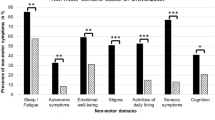Abstract
Cervical dystonia is focal dystonia characterized by involuntary movement of the neck muscle, which leads to abnormal head posture. It can be accompanied with pain and tremor. In this study, we evaluated the presence of depression and anxiety in patients with cervical dystonia and the influence of dystonia symptoms on the quality of life. Psychiatric symptoms were evaluated by use of the Beck Depression Inventory (BDI-II) and Beck Anxiety Inventory. Toronto Western Spasmodic Torticollis Rating Scale (TWSTRS) was used to evaluate the cervical dystonia symptoms. Quality of life was assessed by the craniocervical dystonia questionnaire (CDQ-24) and short form 36 health survey (SF-36). Nineteen patients were analyzed. Most of the patients had mild cervical dystonia (mean TWSTRS 23.89). Depression was present in 42.1 % and anxiety in 57.9 % of the patients. Disability due to cervical dystonia correlated with the occurrence of depression (ρ = 0.534) and anxiety (r = 0.652). Disability was found to significantly influence the stigma, emotional state, pain, daily activity, social life, physical function, and physical and mental disability. Pain influenced some aspects of body pain, physical function, and physical and mental disability. Being associated with disability and pain, cervical dystonia decreases the quality of life in many aspects. Disability also influenced depression and anxiety, which were present in half of study patients. In addition to follow up for cervical dystonia symptoms, patients with cervical dystonia should also be assessed for psychiatric symptoms on routine clinical check-ups. In addition to botulinum toxin, psychopharmaceuticals should be considered as a treatment option in these patients.
Similar content being viewed by others
REFERENCES
Albanese A, Bhatia K, Bressman SB, Delong MR, Fahn S, Fung VS et al (2013) Phenomenology and classification of dystonia: a consensus update. Mov Disord 28:863–873
Van Zandijcke M (1995) Cervical dystonia (spasmodic torticollis). Some aspects of the natural history. Acta Neurol Belg 95(4):210–215
Mordin M, Masaqeul C, Abbott C, Copley-Merriman C (2014) Factors affecting the health-related quality of life of patients with cervical dystonia and impact of treatment with abobotulinumtoxin A (Dysport): results from a randomized, double-blind, placebo-controlled study. BMJ Open 4:e005150
Albanese A, Sorbo FD, Comella C, Jinnah HA, Mink JW, Post B et al (2013) Dystonia rating scale: critique and recommendations. Mov Disord 28:874–883
Consky ES, Lang AE (1994) Clinical assessments of patients with cervical dystonia. In: Jankovic J, Hallett M (eds) Therapy with Botulinum Toxin. Marcel Dekker, Inc., New York, pp 211–237
Beck AT, Steer RA, Garbin MB (1988) Psychometric properties of the Beck Depression Inventory. Twenty-five years of evaluation. Clin Psychol Rev 8:77–100
Beck AT, Epstein N, Brown G, Steer RA (1988) An inventory for measuring clinical anxiety: psychometric properties. J Consult Clin Psychol 56:893–897
Müller J, Wissel J, Kemmler G, Voller B, Bodner T, Schneider A, Austrian Botulinum Toxin and Dystonia Study Group et al (2004) Craniocervical dystonia questionnaire (CDQ-24): development and validation of a disease-specific quality of life instrument. J Neurol Neurosurg Psychiatry 75:749–753
Ware JE (2000) SF-36 health survey update. Spine 25:3130–3139
Kilbane C, Ostrem J, Galifianakis N, Grace J, Markun L, Glass GA (2012) Multichannel electromyographic mapping to optimize Onabotulinumtoxin A efficacy in cervical dystonia tremor. Other Hyperkinet Mov 2: pii tre-02-91-598-1
Moraru E, Schnider P, Wimmer A, Wenzel T, Birner P, Griengl H et al (2002) Relation between depression and anxiety in dystonic patients: implications for clinical management. Depress Anxiety 16:100–103
Müller J, Kemmler G, Wissel J, Schneider A, Voller B, Grossmann J, Austrian Botulinum Toxin and Dystonia Study Group et al (2002) The impact of blepharospasm and cervical dystonia on health-related quality of life and depression. J Neurol 249:842–846
Fabbrini G, Berardelli I, Moretti G, Pasquini M, Bloise M, Colosimo C et al (2010) Psychiatric disorders in adult-onset focal dystonia: a case-control study. Mov Disord 25:459–465
Gündel H, Wolf A, Xidara V, Busch R, Ladwig KH, Jacobi F et al (2003) High psychiatric comorbidity in spasmodic torticollis: a controlled study. J Nerv Ment Dis 191:465–473
Slawek J, Friedman A, Potulska A, Krystkowiak P, Gervais C, Banach M et al (2007) Factors affecting the health-related quality of life of patients with cervical dystonia and the impact of botulinum toxin type A injections. Funct Neurol 22:95–100
Kiss ZH, Doig-Beyaert K, Eliasziw M, Tsui J, Haffenden A, Suchowersky O (2007) The Canadian multicentre study of deep brain stimulation for cervical dystonia. Brain 130:2879–2886
Werle RW, Takeda SY, Zonta MB, Guimarães AT, Teive HA (2014) The physical, social and emotional aspects are the most affected in the quality of life of the patients with cervical dystonia. Arq Neuropsiquiatr 72:405–410
Papathanasiou I, MacDonald L, Whurr R, Jahanshahi M (2001) Perceived stigma in spasmodic torticollis. Mov Disord 16:280–285
Author information
Authors and Affiliations
Corresponding author
Ethics declarations
Conflict of interest
Auth or A received honoraria from Abbvie d.o.o, Ewopharma d.o.o, Pliva Teva d.o.o., Medis d.o.o; and received financial support for attending symposia from Abbvie d.o.o. and Medis d.o.o. Author B has no conflict of interest. Author C has no conflict of interest. Author D has no conflict of interest. Author E received honoraria from Pliva Teva d.o.o. Author F has no conflict of interest.
Ethical approval
This study was performed in compliance to ethical standards.
Informed consent
All the patients gave their informed consent prior entering the study.
Rights and permissions
About this article
Cite this article
Tomic, S., Petkovic, I., Pucic, T. et al. Cervical dystonia and quality of life. Acta Neurol Belg 116, 589–592 (2016). https://doi.org/10.1007/s13760-016-0634-1
Received:
Accepted:
Published:
Issue Date:
DOI: https://doi.org/10.1007/s13760-016-0634-1




